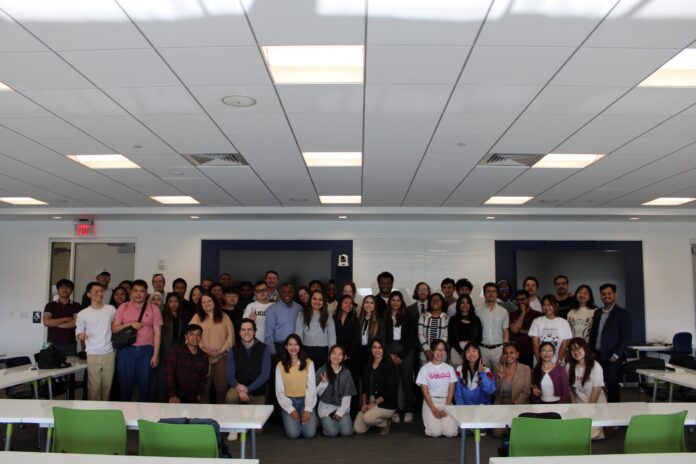Write an article about
On April 28, students in a Technology Innovation and Entrepreneurship class capped off their academic year-long entrepreneurial journey by pitching their technology-based startup ventures at the course’s final pitch day.
The event, held at the Innovation Partnership Building, featured eight student teams presenting to an audience of guest judges, peers, and visiting international students. A networking hour with light refreshments followed, offering time for further discussion and connection.
The course, co-taught by Dr. Leila Daneshmandi from the College of Engineering and Sam Nanayakkara from the School of Business, is an interdisciplinary, project-based class that brings together students from across campus to form teams and tackle real-world problems with innovative technology solutions.
This year’s cohort included students from five UConn schools and colleges: Engineering; Business; Nursing; Fine Arts; and Agriculture, Health and Natural Resources. Participants ranged from first-year undergraduates to graduate students.
The Flexapy team presenting their mobile app pitch idea to a panel of judges. (UConn Photo/Sarah Redmond)
“The students have to work across disciplines, build communication skills, and collaborate as a team. That’s part of their learning journey,” said Nanayakkara. “They’re not just learning how to start a company, they’re learning how to work with people who think differently from them, how to adapt, and how to lead. These are skills that apply far beyond entrepreneurship, whether they go into startups, industry, or any field where innovation and collaboration matter.”
Many of the 26 students began developing their ventures in the fall semester’s Technology Innovation and Entrepreneurship I course. That course introduces ideation, design thinking, and business models.
The spring sequel focuses on startup strategy, product-market fit, prototyping, and financials. Together, the courses form a year-long, hands-on sequence designed to help students build viable, scalable technology ventures. No prior experience is required to enroll in the Fall course.
This spring, Joseph Luciani from the College of Engineering’s Innovation Shop joined the instructional team, providing students with support in prototyping and technical development, further strengthening the course’s emphasis on building real, working solutions.
The student teams focused on solutions across a wide range of areas, including charging infrastructure, AI regulations, energy trading, healthcare, elderly care, mobility assistance, physical therapy, and agriculture. The ventures pitched were OptiEnerX, Safety Assurance Index, SoleShift, Transferable, PowerBid, Goldilocks, SmarThyCheck, and Flexapy.
The audience also included 24 visiting students from the U.S. Department of State’s Young Southeast Asian Leaders Initiative (YSEALI), who were on campus for a five- week entrepreneurship program hosted by UConn’s Global Training and Development Institute. The YSEALI students observed the final presentations, asked thoughtful questions, and joined the networking session following the pitches.
“The event was a perfect reflection of UConn’s entrepreneurial spirit and culture of innovation,” said Dr. Tolga Turker, Director of Global Entrepreneurial Programs at UConn’s Global Development and Training Institute. “The student pitches showcased bold imagination and real-world problem-solving, inspiring the YSEALI fellows to pursue their own ideas.”
A panel of guest judges provided constructive feedback and insights, helping teams refine their ideas and build confidence in presenting to external stakeholders.
The event also welcomed course alum Sage Bhagwansingh, founder of Sage Scenes, who returned to support the event and contributed videography, demonstrating the strong and growing community around UConn’s innovation programming.
“It is incredibly rewarding for us to see how far these students have come, not just in developing their ventures but in how they think, communicate, and lead. We challenge them to step outside their comfort zones and take ownership of the process, from problem discovery to real-world prototyping and startup strategy,” said Daneshmandi, who is also the director of the College of Engineering’s Entrepreneurship Hub. “What they gain is not just entrepreneurial knowledge. It is confidence, adaptability, and an innovative mindset that will stay with them no matter where they go next.”
Students interested in exploring technology entrepreneurship are encouraged to reach out to Daneshmandi. Both courses are offered jointly through the College of Engineering and the School of Business and are open to students of all majors and designed to support innovators at every stage.
For more information about support for technology innovation and entrepreneurship, please visit the eHub.
View photos from the event.
make it easy to read for teens.Organize the content with appropriate headings and subheadings (h1, h2, h3, h4, h5, h6) and made content unique. Include conclusion section and do not include the title. it must return only article i dont want any extra information or introductory text with article e.g: ” Here is rewritten article:” or “Here is the rewritten content:”

